Key takeaways:
- Personalization is crucial; tailor each query letter to reflect the specific interests of the agent to enhance chances of success.
- Understanding and following agent submission guidelines can prevent unnecessary rejections and improve professionalism.
- Viewing rejections as learning opportunities can lead to growth and help refine your manuscript.
- Effective research on agents, including their preferences and trends through social media and literary events, can streamline the querying process.
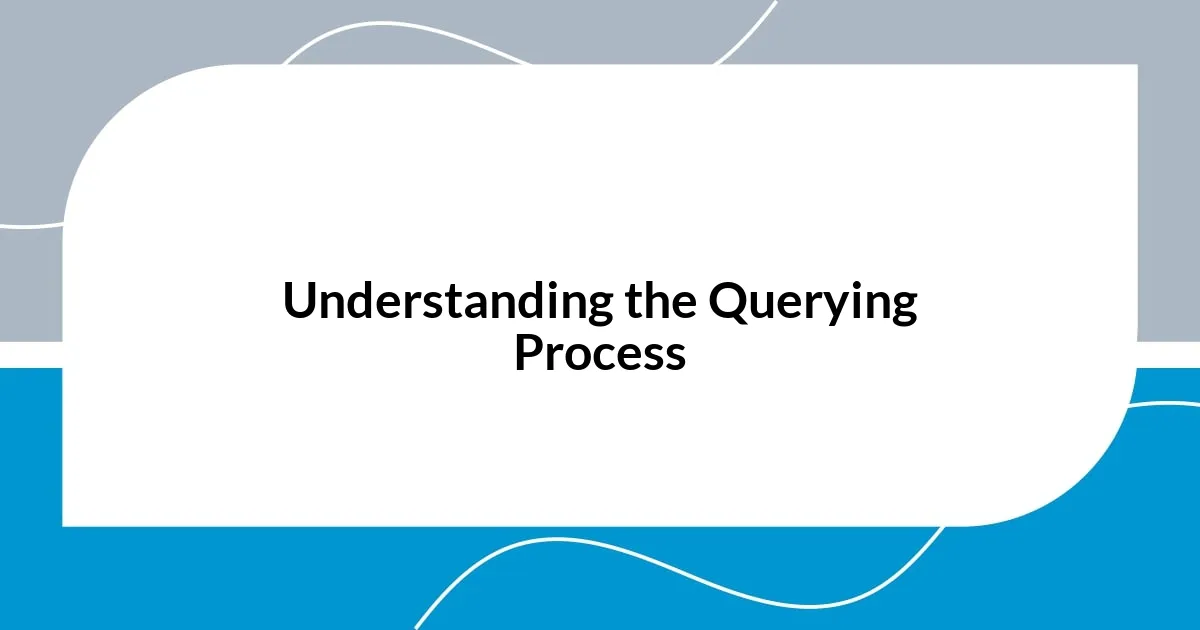
Understanding the Querying Process
The querying process can often feel like standing at the edge of a vast ocean, full of unknowns and daunting waves. I remember when I first dipped my toes into this world; the sheer number of agents and submission guidelines was overwhelming. It felt like trying to find my way through a labyrinth where every turn led me to a new set of requirements.
As I delved deeper, I learned that understanding an agent’s preferences is crucial. I recall a time when I risked sending my manuscript indiscriminately to several agents without tailoring my query letters. Not only did I miss the mark, but I also received polite rejections that stung more than I expected. This experience taught me the importance of research—finding an agent whose interests align with my work can make all the difference.
Navigating the querying process is about more than just sending off your manuscript. It’s a journey that requires patience, resilience, and a willingness to adapt. Have you ever felt the nerve-wracking anticipation of hitting “send” on an email? That moment can be exhilarating yet terrifying, but it’s also a powerful step towards your publishing dreams. Every query is a chance not just for feedback, but for growth.
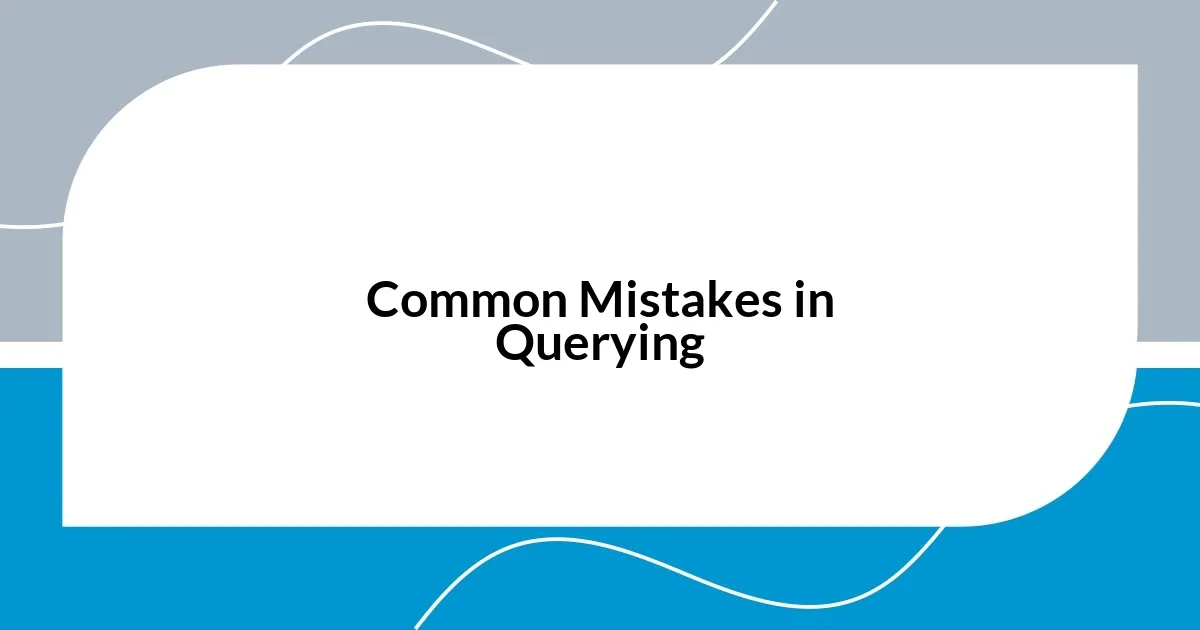
Common Mistakes in Querying
One of the biggest mistakes I see aspiring authors make is falling into the trap of generic queries. When I first started querying, I thought a polished manuscript was enough. I sent out the same letter to multiple agents, not realizing that each one looks for something unique in a writer’s voice. This cookie-cutter approach often results in missed opportunities.
Here are some common missteps to avoid:
- Ignoring Agent Guidelines: Each agent has specific submission preferences. Double-checking these can save you from instant rejections.
- Neglecting Personalization: Tailor your query letter to reflect why you chose that particular agent. A simple sentence can show you did your homework.
- Overloading Information: Presenting too much detail about your manuscript can overwhelm agents. Keeping it concise yet compelling is key.
Another mistake is overlooking the importance of a professional query letter format. I recall submitting my first batch of queries without realizing how crucial it was to adhere to industry standards. An unprofessional appearance can quickly turn an agent off. You really want to make that first impression count!
Consider these elements:
- Proper Addressing: Address the agent by name. It feels more personal, and it’s always appreciated.
- Clear Subject Lines: Opt for something straightforward like “Query: [Your Manuscript Title]”—it sets the stage.
- Polite Closing: Always end your letters courteously. It reflects professionalism and respect for the agent’s time.
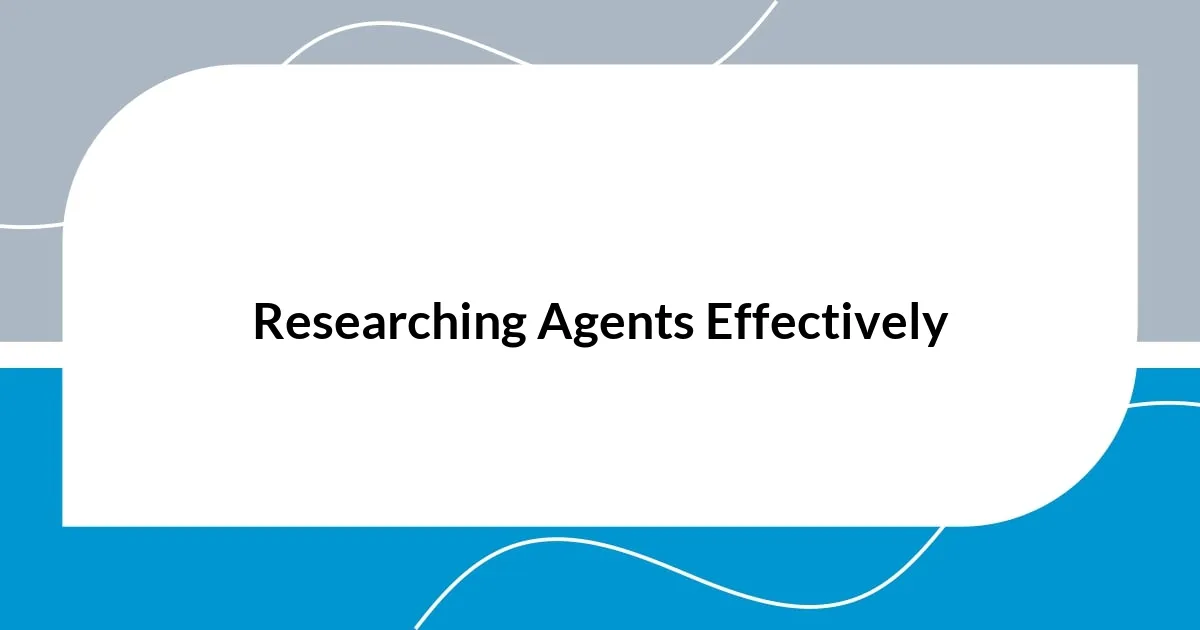
Researching Agents Effectively
Researching agents effectively is about more than just a simple Google search; it’s about finding a connection with someone who understands your work. I remember spending hours on literary agency websites, not just reading bios but also looking at their client lists and recent sales. I learned that every agent has unique tastes and trends they gravitate towards. By evaluating their interests and the type of projects they champion, I felt more confident in tailoring my submissions.
A strategic approach to this research can greatly enhance your chances of success. I’ve found that using social media platforms, like Twitter and Instagram, can provide invaluable insights. Agents often share their preferences and projects they’re excited about, which helps you gain a sense of what they’re currently seeking. Additionally, industry events and writer conferences offer opportunities to connect with agents directly. Meeting them in person can be a real game-changer—even a friendly chat can make your future query stand out.
While researching agents, keep track of your findings to create a personalized submission list. I always used a simple spreadsheet to note agents’ interests, submission guidelines, and any specific quirks they mention in their profiles. This little step transformed my querying process from overwhelming to organized, allowing me to approach each agent with a tailored query that showed genuine interest.
| Research Method | Expected Outcome |
|---|---|
| Literary Agency Websites | Detailed understanding of agent preferences and submission guidelines |
| Social Media Engagement | Insights into current trends and personal connections with agents |
| Industry Events | Opportunities for in-person connections and networking |
| Tracking in Spreadsheets | Structured organization of potential agents for targeted queries |
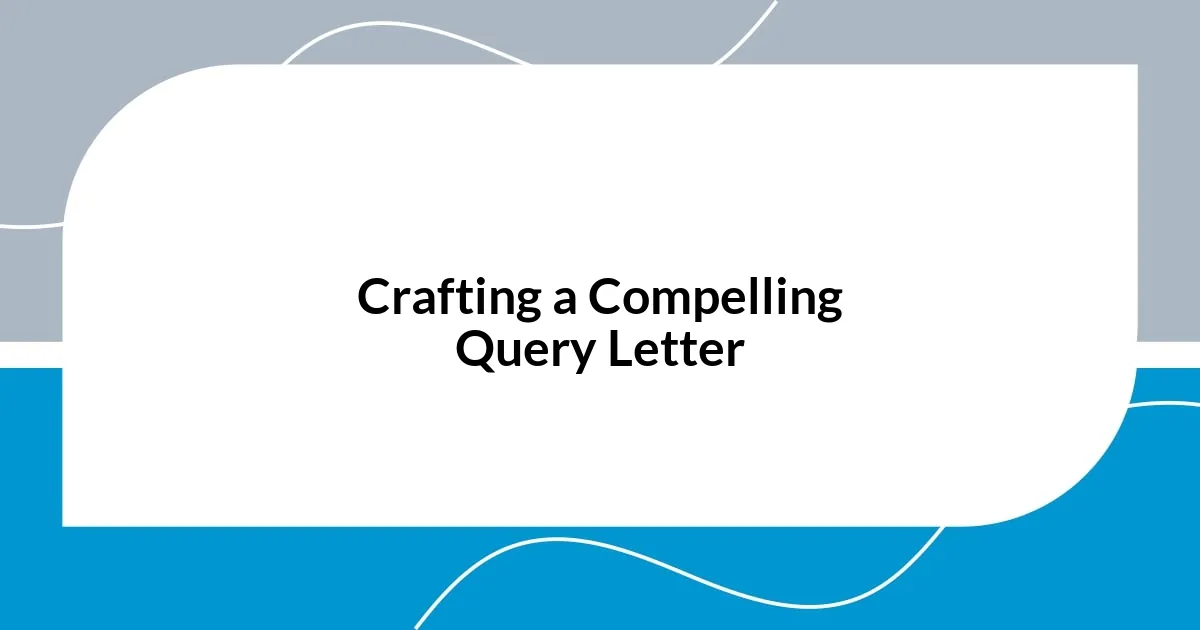
Crafting a Compelling Query Letter
Crafting a compelling query letter is like stepping onto a stage. I remember the first time I poured my heart into a letter, only to realize I had forgotten to include the most vital part: a succinct summary of my manuscript. It was an eye-opening moment, realizing that agents often sift through countless queries daily. What’s the one thing I wish I’d known earlier? Clarity and brevity win the day.
While writing your letter, it’s essential to hook the agent immediately. I learned that starting with a strong opening line can be the difference between catching their attention and getting lost in the shuffle. A personal story or an intriguing question related to your book’s theme can draw them in. For instance, instead of stating “My book is a contemporary romance,” I shifted to “What if the one person meant to overcome your fears is the very person who embodies them?” That small tweak made my query stand out, sparking interest right off the bat.
Don’t underestimate the power of an emotional connection. I once included a brief anecdote about my experience that inspired my manuscript, and it resonated with an agent who had faced similar struggles. Sharing that vulnerability transformed my query from a mere pitch into a conversation. Remember, agents are not just looking for a great story; they want to feel something, too. So, how can you infuse your personality into your letter while keeping it professional? It’s all about striking the right balance—be authentic, yet polished.

Tailoring Your Query to Fit
When I started querying, I quickly realized that a one-size-fits-all approach just doesn’t work. In my early attempts, I sent the same letter to multiple agents, only to face rejections that made me question my manuscript. Once I began to customize my queries—mentioning why I was drawn to each agent’s work or how my book aligned with their client list—it felt like I was not just submitting a query, but having a meaningful conversation. This personalized touch turned things around for me.
I learned that tailoring my query involved more than just tweaking a few sentences. For example, I remember one particular agent who specialized in historical fiction. I made sure to highlight the unique setting and meticulously researched details of my book that I thought would resonate with their tastes. It not only showed that I did my homework, but it also demonstrated my respect for the agent’s expertise and preferences. Just that small effort to align my writing with their niche made my pitch feel more relevant and exciting.
Have you ever considered how a simple tweak in wording could dramatically shift the focus of your letter? I once had a breakthrough when I changed how I introduced my protagonist. Instead of labeling them with generic traits, I painted a vivid picture of their struggle and hopes. This left the agent with a strong emotional hook and a clearer understanding of my story’s heart. Remember, this is your moment to shine; don’t shy away from revealing what makes your manuscript unique. Tailoring your query is not just about fitting a mold—it’s about celebrating the individuality of your work to create a impact.
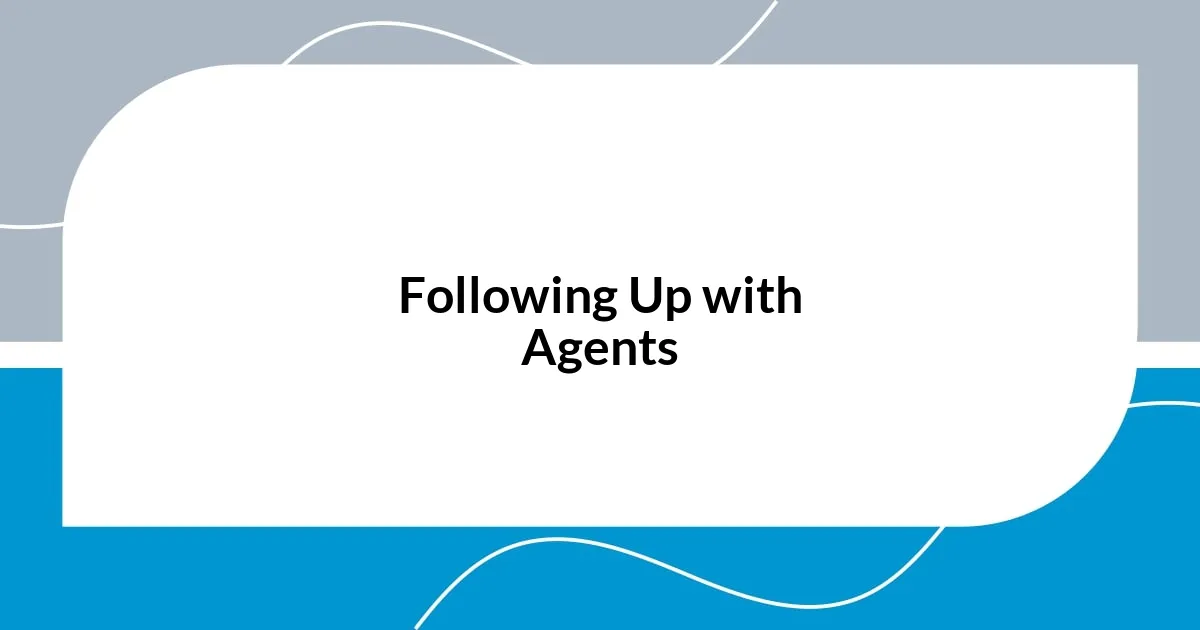
Following Up with Agents
Following up with agents can feel daunting, but it’s an essential part of the querying process. I remember pacing around my living room, checking my inbox obsessively after sending my first batch of queries. After waiting longer than I anticipated, I decided to revise my approach. Agents appreciate the occasional nudge, but there’s a fine line between being persistent and pushy.
When I finally sent my first follow-up email, I kept it simple and respectful. I stated when I sent my query and expressed continued interest in their feedback, allowing my voice to reflect both eagerness and professionalism. It was affirming to receive a response shortly after—many agents actually appreciated the reminder! I learned that while silence can be nerve-wracking, a well-crafted follow-up can demonstrate your dedication to your work and help maintain communication.
Have you considered the timing of your follow-up? I waited about six weeks before nudging a particularly appealing agent who had a reputation for being responsive. Knowing their timeline from industry research helped me gauge the right moment to check in. I was thrilled when I received a positive reply that included a request for my full manuscript. This experience taught me that following up isn’t just about pinging agents; it demonstrates your commitment to the process and your belief in your story. Balancing patience with initiative was a lesson I wish I had grasped earlier!
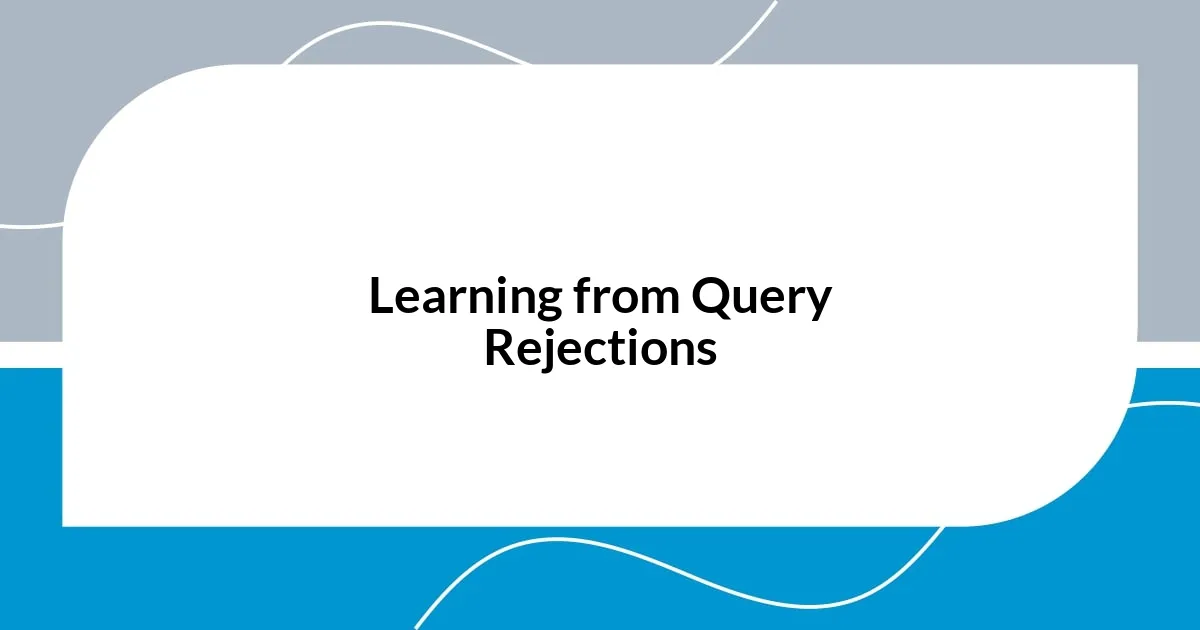
Learning from Query Rejections
Learning from rejections can sting, but I’ve discovered it’s a golden opportunity for growth. After receiving my first few rejections, I took a step back and truly evaluated the feedback—or lack thereof. Were agents citing specific issues with my writing, or was it just a pass? That reflection forced me to identify patterns and sharpen my manuscript, ultimately pushing me toward a more polished draft.
One rejection that stood out was accompanied by a personalized note from an agent. They expressed appreciation for my writing style but felt the story lacked a clear conflict. This feedback struck me deeply. Instead of feeling disheartened, I got to work, digging deeper into my characters’ motivations and introducing stakes that were more palpable. This experience taught me the importance of viewing rejections not as failures, but as valuable insights from professionals who are invested in stories.
Have you ever felt paralyzed by a string of rejections? I certainly did at one point. Yet, I realized that these moments of vulnerability could lead to breakthroughs. I started joining writing groups to share my experiences and gather diverse perspectives. Hearing others’ journeys reassured me that rejection is part of the process. It’s a reminder that behind every published book lies a trail of “no’s,” and these experiences ultimately lead to growth and resilience. With every rejection, I embraced the learning curve, and it’s made my writing journey all the more meaningful.